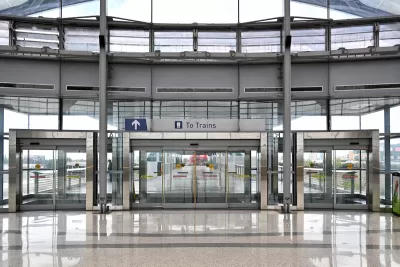Regional transit coordination provides the best transit experience in an urban area. It enables better, more affordable transit which in turn improves ridership. After 50 years of experience in Europe, the U.S. should finally embrace the concept.

As professional transportation planners researching the topic of regional transit coordination in metropolitan areas, we encourage everyone — including politicians, transit riders, transit agencies and anti-bureaucracy advocates — to educate themselves about the possibility and promise of transit coordination. The SB 397 (State Senator Wahab, CA-District 10) proposal for the consolidation of transit agencies in the San Francisco Bay Area is on the right track, but our research findings suggest there are a range of possible approaches to coordination, and, in our opinion, it is premature to select a definitive solution for most of California’s metropolitan areas.
Transit coordination achieves results
Organizations responsible for multi-agency transit coordination are not new. Indeed they have been effective in Europe for over half a century, and as our research shows, we are beginning to see successful examples in the United States as well. First created in Hamburg in 1965, they have since been adopted by virtually all of Germany's urban areas, spreading to the rest of Europe as well. Anyone who has used European transit recognizes how much more affordable and efficient it is. Regional transit coordinators (RTC) are an important part of this success. In fact, the large number of regional transit managers led to the establishment of the European Metropolitan Transport Authorities (EMTA) association. A properly-empowered RTC agency enables unified fares, marketing, and coordinated regional planning—all critical elements that yield unmatched efficiency and effectiveness.
Our research shows that there are two basic models for such an organization: Coordination and Consolidation. The Coordination Model spread throughout Germany where it was invented and where there are now over 50 agencies in both large and small urban areas. Conversely, although inspired by German success, the Consolidation Model was adopted in Sweden, where the state government is responsible for all transit (as is our State of New Jersey). Regional Transit Coordinating agencies go by various names (verkehrsverbund in German, and Transport Authority, Regional Transit Coordinator, and Network Manager in English) but no matter the label, they ensure the provision of a single fare structure, coordinated schedules, unified marketing (and sometimes branding), and long-term regional transit planning, even though there may be multiple transit providers, as in Frankfurt where there are more than 25 members of the Rhein-Main Verkehrsverbund (RMV).
Research supports the benefits of coordinating transit
California and other states would benefit from recognizing the value that such agencies can provide, discussing the best ways and means to implement them, and then beginning the process to do so. We strongly encourage anyone interested in this issue to review our current and past Mineta Transportation Institute (MTI) research reports on this topic—including Characteristics of Effective Metropolitan Areawide Public Transit: A Comparison of European, Canadian, and Australian Case Studies, the forthcoming MTI report Governing Structures for Successful Regional Transit Coordination and Their Formation as well as papers published by others, including Homburger, Beuhler, Dümmler, Van de Velde, Sorensen, Pucher and Hirschhorn.
While we support efforts to coordinate the Bay Area’s 27 agencies, it is premature to claim that consolidation is the best answer, just as it is short-sighted to condemn coordinating agencies categorically. As real-world experiences in Germany, Italy, Spain, and even Phoenix, Arizona (Valley Metro) show, coordination can be just as effective as full consolidation. Therefore, taking steps to coordinate and increase transit affordability (as a unified fare system would) is not a bad thing as some past critiques of SB 397 have claimed; quite the opposite: it would clearly lead to increased transit use as Buehler et al 2013 has shown. That is not to say that consolidating roles where it makes sense should not be investigated. For example, one consolidated role leading to greater efficiency comes from designating a regional agency to coordinate multi-operator procurements. When done right, everyone gets the equipment they need at a lower price. And this is just the beginning.
On the other hand, some aspects of planning and providing transit services, most notably local bus routing, should be planned locally, as they still are in Europe even when there is a regional transit coordinating agency. However, regional transit services like BART, Caltrain, SMART and ACE are another matter, and at a minimum, inter-agency communication on how to best serve the nine-plus counties is warranted. No other U.S. metropolitan area has so many separate agencies providing the longer-distance, (i.e. intercity and commuter rail/bus) transit. This is to the detriment of transit riders in terms of necessitating transfers and the payment of additional fares.
Conclusion
In sum, whether one agency or 27, public transit within a single metropolitan area must be coordinated in a seamless, effective, and efficient way, which will attract riders and ensure its survival in this post-pandemic world. We call on the US Federal Transit Administration (FTA) and the State of California to recognize the value and importance of such agencies. Maybe then our metropolitan areas will begin the process of metropolitan areawide transit coordination as most European areas have done. This may be achieved through a German-style verkehrsverbund or Swedish-style full consolidation; however, in either case, the transit riders—as well as the livability—in our metropolitan areas win.
About World Transport Policy and Practice
We invite you to check out the current and past issues of World Transport Policy and Practice. We also invite you to consider submitting your own stories of practices and policies that have moved your community to implement — and embrace — sustainable transportation. Though the journal is free, there are, of course, expenses incurred to ensure a high-quality, graphically engaging journal on an open platform; we rely on contributions from generous donors, and welcome all who can to contribute. Our supporters enable us to continue our 26+ year tradition as a freely accessible journal of practical ideas and examples for building communities based on sustainable transportation. Donations can be made via our website here https://www.worldtransportjournal.org/donate.
WTPP is published by Transportation Choices for Sustainable Communities Research & Policy Institute, a 501c3 nonprofit corporation in the state of California USA. (http://transportchoice.org/) All donations are deductible to the full extent of the law, and TCSC is registered with Benevity.

Trump Administration Could Effectively End Housing Voucher Program
Federal officials are eyeing major cuts to the Section 8 program that helps millions of low-income households pay rent.

Planetizen Federal Action Tracker
A weekly monitor of how Trump’s orders and actions are impacting planners and planning in America.

Ken Jennings Launches Transit Web Series
The Jeopardy champ wants you to ride public transit.

Philadelphia Is Expanding its Network of Roundabouts
Roundabouts are widely shown to decrease traffic speed, reduce congestion, and improve efficiency.

Why Bike Lanes Are Good: An Explainer for the US Transportation Secretary
Sean Duffy says there’s no evidence that bike lanes have benefits. Streetsblog — and federal agencies’ own data — beg to differ.

California Invests Additional $5M in Electric School Buses
The state wants to electrify all of its school bus fleets by 2035.
Urban Design for Planners 1: Software Tools
This six-course series explores essential urban design concepts using open source software and equips planners with the tools they need to participate fully in the urban design process.
Planning for Universal Design
Learn the tools for implementing Universal Design in planning regulations.
Ada County Highway District
Clanton & Associates, Inc.
Jessamine County Fiscal Court
Institute for Housing and Urban Development Studies (IHS)
City of Grandview
Harvard GSD Executive Education
Toledo-Lucas County Plan Commissions
Salt Lake City
NYU Wagner Graduate School of Public Service






























